Welcome to a new issue of the Journal of Runic Studies, the premier Malkioni publication for studies into the nature of Glorantha. If you haven’t subscribed yet, please consult with the spirit bound to the appropriate electronic page.
God Learner Sorcery
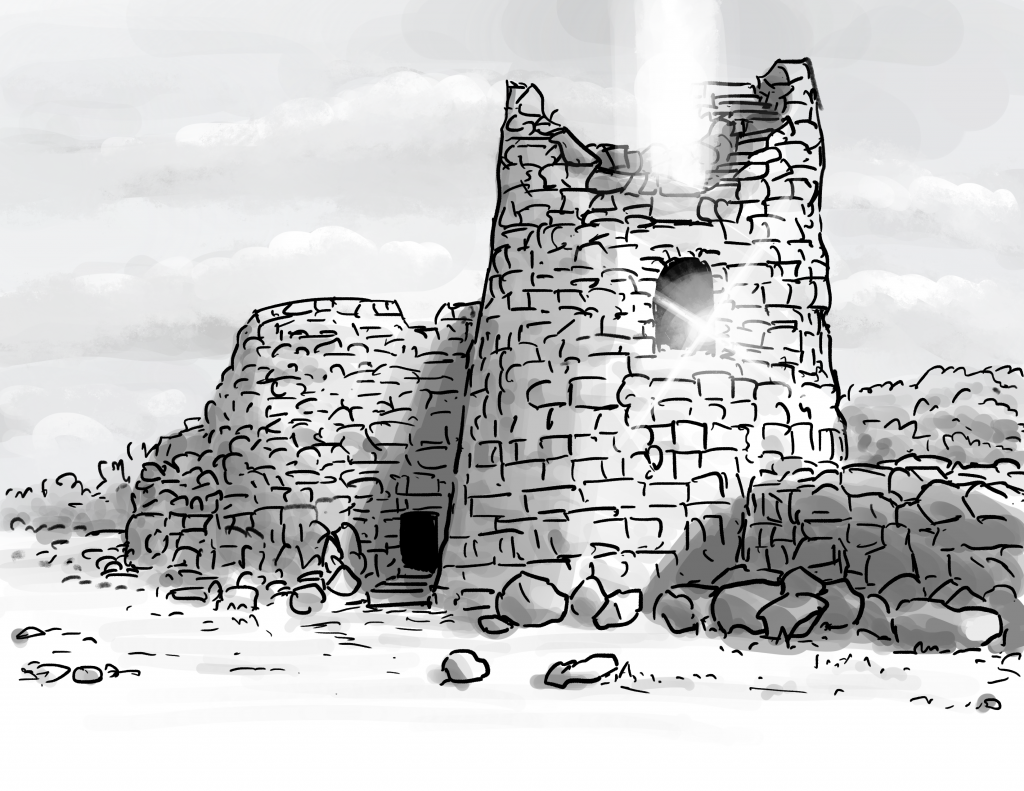
Here is what us God Learners were up to this week.
Review: RuneQuest Weapons & Equipment
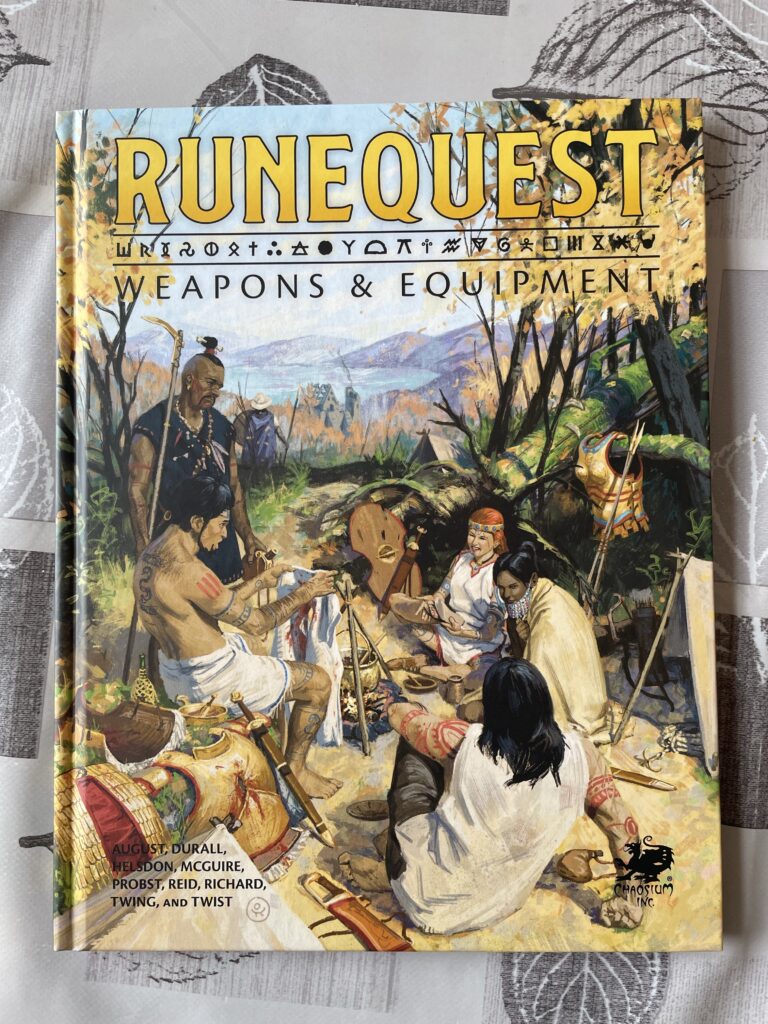
I finally wrote a review of the RuneQuest Weapons & Equipment! This is a long-form review, but it’s maybe not as long as it may seem since there’s a lot of pictures too (the book is so pretty!) You might read things that echo what you’ve seen in other reviews, but you might also read a few new takes and comments on the book. Either way, I hope you find it interesting!
Chaosium News

Here are this week’s Chaosium news!
The RuneQuest Starter Set in Two Minutes
Do you want to convert your players to RuneQuest, but they have a short attention span? Noura Ibrahim, who played in the Glass Cannon RuneQuest game, has got you covered!
She has posted this sponsored two-minute look at the Starter Set, with a promo code at the end for ordering the box. Your players have no more excuses!
Interview with Jason Durall: Breaking the Lore
RuneQuest creative director Jason Durall talks about when to break away from “canon” in your game, and how much you can get away with. There are a couple nods to the usual “Your Glorantha Will Vary” motto but the interview is generic and broadly applicable to all games.
Chaosium Con 2023 Announcements
Guest contribution by Jörg, with some edits by Ludo

As the date approaches (13th to 16th April 2023) for the second ChaosiumCon, game slots have been filling up, more game are being offered, and various blog posts give details about upcoming events and panels.
The Cults of RuneQuest Panel will have Jeff Richard and Jason Durall presenting this milestone of Glorantha publications. Seth Skorkowski will be returning to Chaosium Con and star in three panels, one of which (Podcasting 101) will also feature our own Ludovic-aka-Lordabdul as one of panelists. There will be several other panels for other Chaosium games with luminaries from the respective fandoms, like the H.P. Lovecraft Historical Society.
Prosopaedia Preview


Jeff shared these photos of the upcoming Prosopaedia book… looks good! I’m starting to suspect there might be advance copies at ChaosiumCon… fingers crossed!
BRP SRD vs Big Gold Book
We know that a new edition of the Basic Roleplaying book is coming out soon, but Rick Meints has also confirmed that there would be a free PDF containing just the BRP SRD (System Reference Document):
There will be a free SRD related PDF for BRP with no art, etc. That’s part of the ORC license announcement.
We will also be selling a hardcover full color BRP book with color art (PDF option as well).
Jonstown Compendium

The Jonstown Compendium is Chaosium’s community content program for all Gloranthan games, hosted on DriveThruRPG. Disclaimer: all the relevant links are affiliate links that hopefully will let us cover some of the hosting and maintenance costs for the website and podcast! Thanks for using them!
Edge of Empire in Print
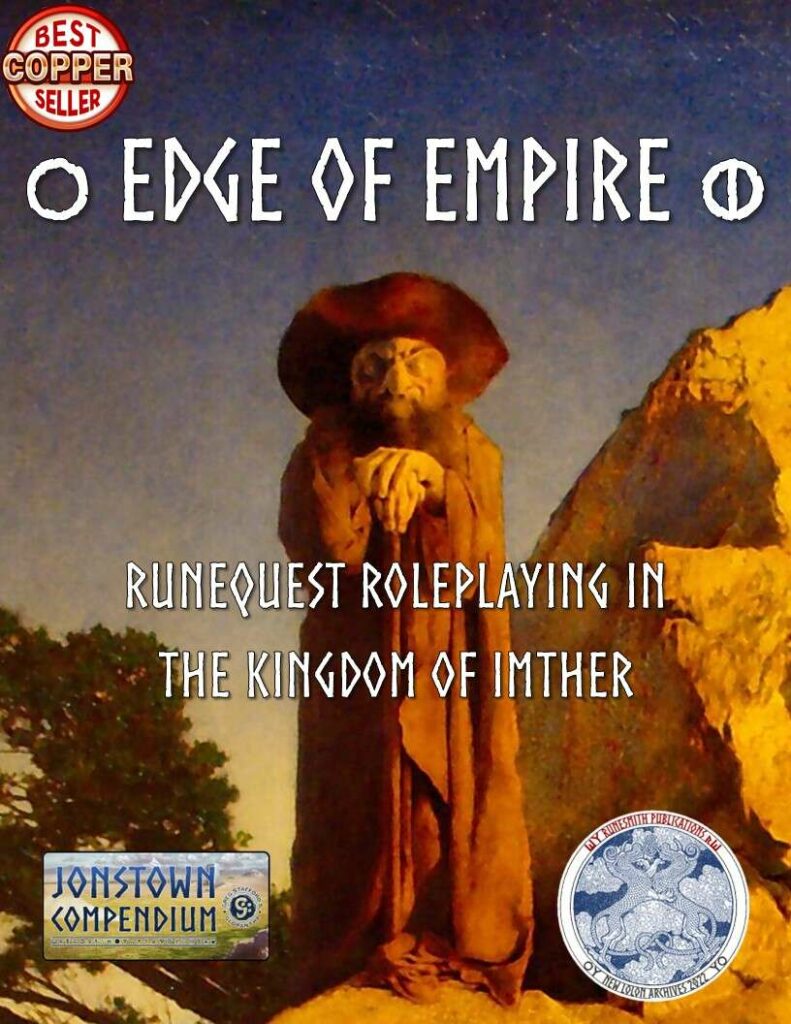
Harald Smith’s Edge of Empire supplement on the Kingdom of Imther is now available in print on demand! If you want to know more about it, you can listen to our interview with Harald.
Edit: I forgot to note that the cover has changed for the print on demand version! Check it out below!
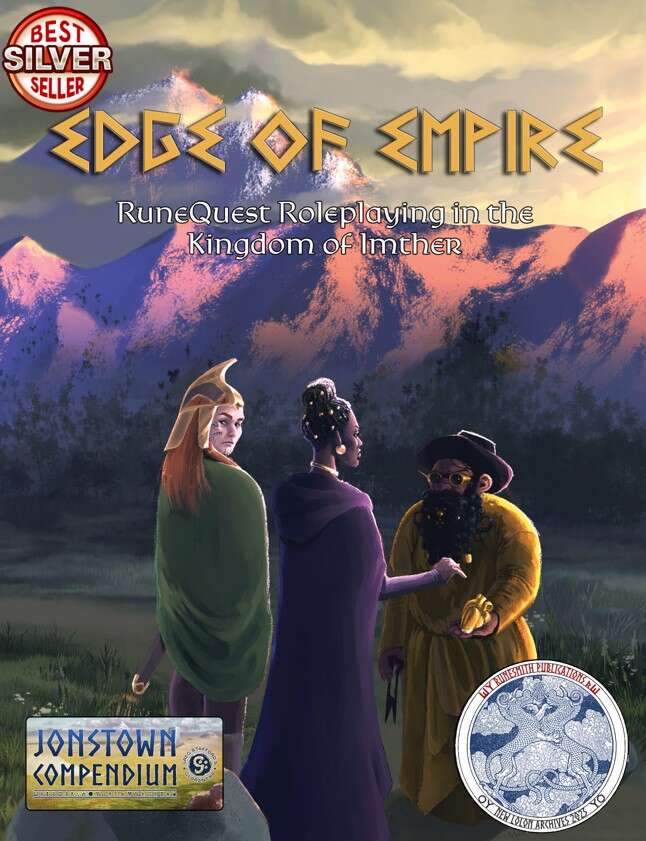
Jeff’s Notes

Jeff Richard, the current mastermind on everything Gloranthan at Chaosium, is often posting notes and thoughts on the RuneQuest Facebook group. Here’s our curated list from the past week. A partial archive of these sources is compiled on the Well of Daliath.
Tartyra the Humakti vs. Anaxos the Horali
Jeff compares a Humakti initiate with a Horali soldier from the West. The Humakti, of course, goes into combat with the help of her Rune magic, spirit magic, and any bonuses or protection cast by allies. The Horali are similar in some ways, and different in others:
When Anaxos the Horali goes into combat, he is aided by friendly spirits to aid him in minor ways as well. He might also belong to a martial cult (if permitted by the local talars). Anaxos is Seshnegi, and his talars have enrolled a local (and limited) version of Humakt – giving him access to Truesword. Although he has good armor and well trained, he has less direct access to magic than his barbarian equivalent.
So Anaxos is a member of the Horali caste, i.e. the soldier cast in Malkioni society. The Talars belong to the noble caste, and the Zzaburi (see below) belong to the sorcerer caste. The last unmentioned cast are the Dronars, the farmers and workers. If you want some inspiration for the way Malkioni society works, you can for instance look at Vedic India and their Varnas, of which there are also four (surprise surprise).
It’s interesting here that the Talars can seemingly enforce “limited access” to a deity otherwise known “in full” elsewhere. I wonder how this is done? Maybe they only allow building shrines, which provide a single Rune spell?
But if the talars demand it, Anaxos is supported by the magic of their wizards, which if properly prepared is every bit as formidable as what [a Humakti] has, and maybe even more! Long term spells such as dampen damage, boon of Kargan Tor, or warding against weapons make Anaxos a terror on the battlefield. But only if Anaxos has the support of his talars and they command their zzaburi to cast those spells.
That’s how sorcery ends up working in Malkioni societies.
The great thing with sorcery is that, given enough time and resources, you can totally overpower spirit and Rune magic. Boon of Kargan Tor (available in the RuneQuest rulebook) gives a bonus to weapon damage, but unlike Truesword (which has a fixed, non-stackable effect) or Bladesharp (which few would have above level 4, and almost none above level 6), it can be boosted very high.
For instance get one sorcerer, three apprentices, and a few servants or magic crystals. The apprentices cast Enhance INT on their boss, each giving him, say, +3 INT. The boss normally has, say, Free INT 8, but now has Free INT 17. Assuming they have mastered the Death Rune and the Summon Technique (it’s their job to provide support to soldiers after all!) they can spend manipulate 17 levels of Boon of Kargan Tor. Let’s spend 8 of those on +2D6 damage, and 9 on duration, so that it lasts two days. Not bad… this is already, on average, better than Bladesharp 6.
At this point, each extra apprentice that can cast Enhance INT gives you an additional +2D6 damage for these two days… so grab those foreign exchange students who skipped your class earlier this week and force them to forget all their spells except Enhance INT. Lo and behold, your Horali goes out for their mission with +6D6 damage on their weapon! Try that with your stupid puny Rune or spirit magic, hah! And that’s even before we consider that this spell could have been written, partially or fully, in a grimoire!
But ultimately, it really depends on Zzaburi support:
Not [sic] that sorcery is very socially useful. It just is not as useful for free-wheeling adventurers. Or members of societies that don’t want to support a bunch of specialist sorcerers.
More here.
Also, yes, I’m totally expecting one of you to send me an email about some sort of sorcery rules mistake I made in the text above. Don’t disappoint me, people!
In Glorantha, Cults Precede Culture
Guest contribution by Jörg
Jeff addresses a couple of perspectives that are common to our modern western society but rather alien to the mindsets of the inhabitants of Glorantha.
To a very significant extent, in Glorantha cults drive culture. By looking at the significant cults (say more than 2% of the population) in any particular community, we can get a quick overview of some of the key components of that community’s culture. Now not all is going to be driven by the cults, but they are important drivers.
Major deities mainly worshipped by humans like Orlanth, Ernalda, Yelm or Lodril do suggest a certain direction of the underlying cultures, but variations can be great.
Across the Lozenge and its history, we have seen these deities followed and worshipped by very different cultures. Orlanth, Ernalda and Yelm are major deities for the Pentans, a patriarchal nomad culture riding horses and raiding sedentary agriculturalists and pastoralists, occasionally lording over them for varying periods of time. In the Grey Age the horse warlords even were bringers of civilization to the dazed survivors of Peloria, all the way to the Sweet Sea, laying the foundations for the urban cultures of that region. Nowadays those same horse rider tribes are seen as ruthless and often inhumane raiders and murderers by the peoples whose ancestors they saved from the lethargy of the Greater Darkness, who worship the same deities in totally different context.
Cults are a rather recent invention in Glorantha: they became necessary to bridge the gap between the everyday world of the mortals and the eternal God Time. God Time had no use for cults, although it knew sacrifice to higher powers… we know Orlanth underwent such preparatory sacrifices before he departed on the Lightbringers’ Quest.
So if Orlanth, Humakt, and Storm Bull are all significant cults in a community, that is going to mean something. Similarly if a third of the community is initiated into Ernalda, that is going to mean something. If both Storm Bull AND the Seven Mothers are present, that is going to mean something as well!
And yet the Storm Tribes of Pent following Dranz Goloi are very different from the White Bull Society, or the Orlanthi of Talastar facing the Chaos threat of Dorastor, despite having demographics fitting the description above.
In God Time, the Orlanthi were literally the people who followed Orlanth in his local presence, e.g. the Durevings on the Downland Migration, the Ram People who invaded Dara Happa under their king Elemalus (not quite Orlanth, but his loyal stand-in Lightfore), or Varnaval and his ordeed-drawn chariots in Pelanda, Their heroic and/or demigod leaders became avatars of the deity, and their mighty deeds often mirrored those of the one deity they all shared. A God Learner might spout technobabble about instantiation of core myths projected on local avatars who in turn get included in the mostly anonymous mass of Storm Brothers for pretty much everyone else worshiping (or following, in Godtime) the same Orlanth but in different local and historical context.
Culture was brought, exemplified or dictated by the cult entities and/or cultural (and cult) heroes. The cults with their rituals attempt to re-live the original establishment of their cult entities’ feats. And many things which are cultural achievements in our world (like e.g. grain cultivation) are divine gifts in Glorantha. Not gifts of the cults, though – at best the cults help in cultivating these gifts.
Now cults do change in Time – but that is a result of their followers continuing interactions and experiences with the God Time, aka heroquesting.
There is also an element of history and cultural exchange (or lack thereof) that will change a cult locally. The entire rabbit-hole of Yelmalio by other names (such as Elmal or Antirius) had diverging cults due to historical or even God Time differences, and saw unifications of quite dissimilar cults by heroquesting.
Why would a heroquester want to change the nature of a cult?
That’s another post – but people tend to assume that hero questers intended the specific experiences they had. But the God Time is not so easily contained or controlled.
More often than not, these changes are made when different cultures come into contact, and new solutions are needed.
And Jeff too points out that just because we know the name of a deity we cannot predict how exactly it will manifest.
More here.
Gods, Archetypes, and the Malkioni Perspective
Jeff reflects on Gloranthan gods:
[…] Each represents an archetype present in the world, is the manifestation of the divine in the mundane world. […]
Many of these archetypes contain contradictions – the Red Goddess is tainted by Chaos, Orlanth is a destroyer and a preserver, etc. – but to me that only enhances their fascination.
Gloranthans have little concern regarding theodicy – the gods are not all-powerful, all-wise, or all-good. They are worshiped because they made the world we mortals live in, and that their cults provide a means for mortal survival within Time.
This, I think, is one of the most interesting aspects of ancient world religion: they seemed to worship gods “as they are”, and not for some sort of idealized role model or moral guide. Most Greek gods were assholes, but they served a purpose and that’s why they were worshipped. It was a very practical thing, as far as I understand. In turn, that provides many roleplaying opportunities that I have yet to explore.
One exception to this might be the Malkioni. Jeff describes their perspective like this in another note:
The Malkioni posit the existence of something all-powerful, all-knowing, and all-good (or at least all-rational) – the Invisible God. That entity is invisible to us – we can’t go “visit it” or be it. This all-powerful, all-knowing, and all-good being does not provide any magic or indeed it does not act, speak, etc. It simply IS. But by studying the world (including the lesser gods), we mortals (or at least those who specialise in sorcery) can impose our will upon the world made by the Invisible God. And this is also good.
The Malkioni make many of the same arguments I see made [on forums and Facebook groups] – that the gods are inconsistent, that they fail to meet the same demands they place on their worshipers, that they are responsible for their degeneration of the world and the coming of Chaos. But those are Malkioni arguments – to most Orlanthi, Praxians, et al, such arguments fall on barren ground.
More here.
Heroquesting as Interaction with the Divine
Jeff re-frames heroquesting as “interacting with the divine“:
Let’s put aside the model created for the KoDP video game, and think about what a heroquest really is – it is a mortal directly interacting with the divine, outside of what is familiar (the temple, sacrifice, the safe home of your god, etc.), and making new experiences with the powers, archetypes, and events of the God Time. It is a dangerous and unpredictable thing.
Jeff first refers to the King of Dragon Pass video game, in which heroquests are reenactments of a myth: the participants try to impersonate their gods as well as they can, and then try to go through the motions of a myth they know. For instance, reenacting the myth of Issaries The Concilliator by going into the God Time and replaying through Issaries’ resolution of a conflict between two animal tribes (by the way, for more myth ideas, check out the KoDP wiki!)
This way of playing heroquests worked well for a video game, especially thanks to the replayability aspects. But it may have leaked into the RPG world with the release of Hero Wars (and its subsequent product line) the following year. This is quite likely since designers like Robin Laws worked on both games. The problem is that RPGs aren’t as conductive as video games when it comes to scripted gameplay.
Greg and I went over this a lot. And we ended up changing the way we described heroquests in order to better reflect his stories.
For RuneQuest Glorantha, it looks like Chaosium is re-framing heroquesting as, effectively, “experimental heroquesting”, where you explore the God Time in search of something new or different. “Safe heroquesting” might be what happens when, for instance, you obtain a new Rune spell. For instance, you follow the instructions given to you by a Storm Voice to go in the God Time and experience Orlanth stealing the Sandals of Darkness from the trolls. You come back with the Dark Walk Rune spell. There was little risk, because this ritual has been perfected over several generations, and you do it at a shrine or temple that has a strong connection with your god. So it’s hand-waved as “my adventurer spends a week at the Orlanth temple” and sacrificing 1 POW.
Going outside of these well-trodden paths lets you experience whatever other random thing Orlanth might have done during the God Time, and bring that back as a custom magical power:
A heroquester typically gains gifts and magic as a result of their experiences, but also banes and curses. Passions and runes may change, and the nature of their community may change as well. And remember, those changes are all unpredictable and fraught with risk. Since the end of the Second Age most people have been very reluctant to heroquest except in the most routine and traditional ways. Two notable exceptions include the Red Goddess and the Orlanth cult. And that helps drive the Hero Wars.
We’ve had a few glimpses into the ever-upcoming heroquesting rules, which indeed include mechanics to model these tropes. If you challenge God Time entities and win, you might be able to yield their magic in the mundane world. If you are defeated, you could lose parts or all of a Passion or Rune affinity, bring a curse upon your community (including probably disastrous Harvest roll modifiers), and of course die.
More here.
Lunar Spies
There isn’t any sort of “centralized spy agency” for the Lunar Empire, but there are many spy networks operating at various levels:
The Empire maintains multiple internal security and spy networks, including the Emperor’s Spoken Word, the Imperial Bodyguard, the Blue Moon Assassins, and various ad hoc groups that report directly to the Emperor’s household. Additionally, satraps, governors, and other powerful officials maintain their own network of spies, assassins, and informers. The Spoken Word also maintains a network of Imperial couriers who can relay a message 150 miles a day, and even faster if sent by Moon Boat.
This is really a snippet of text from the Guide to Glorantha, but since I’ve been looking at Lunar spies lately for my game, I figured I might as well use this opportunity to look into it a bit more!
- The Spoken Word was “inspired” by the Red Emperor around 1372. Its original mission was to uncover and monitor insurrectionists, while also cultivating a group of ultra-loyalists devoted to the Empire. This may have been in response to the loss of many territories to Sheng Seleris and various rebellions at the time.
- The Imperial Bodyguard is one of the four “corps” of the Lunar Army. It includes super bad-ass people like the Full Moon Corps (a magical regiment made of “demigod immortals” who come down from Red Moon and, when killed, go back up to be healed), and the Bloodspillers (Jar-eel’s personal regiment, dedicated to her and her “Moonsword cult”)
- Blue Moon Assassins are trolls from the Blue Moon Plateau, in the northeastern edge of the Empire. They are… well, secretive. You don’t see them coming. They have secret agendas involving the Lunar Empire and the Red Goddess. Unlike most trolls, they don’t mind the Red Moon’s association with Chaos. They have secret ways for moving around undetected. There’s not much information on them in the published material, which is probably how they like it. Fun fact: the Blue Moon is the goddess of secrets and potatoes.
Mmmh… which one of those should I send after my players? What did you say? All three? Sounds good!
Argrath and the Telmori
There’s a bit in King of Sartar indicating that Argrath might have wiped out the Telmori tribe from Sartar around 1928 (see the reference on the Well of Daliath). However, it doesn’t explain why he did so except that “King Argrath would not tolerate the wolfmen’s attacks“. Jeff provides a bit of extra information but still leaves the question open:
In 1628, encouraged by opponents of Prince Argrath, Telmori rebelled before Argrath’s army left Sartar to cross the Dragonspine. Rather than be distracted from his goal, Argrath ignored the Telmori. However, upon his return to Boldhome the following year, Argrath suppresses the Telmori uprising.
How the Telmori get suppressed is something that your campaign likely decides. Maybe Argrath sends in the Storm Bull cult and Humakti to do it, forcing the werewolves out of Dragon Pass. Maybe Argrath defeats the ringleaders and makes a new pact with the remaining Telmori. Who knows for certain, except in your campaign.
There’s also more here and here about the ties between Telmori and Sartar’s lineage (including several marriages, and friendliness with the Humakt cult). The second link even has an extra bit about how the Telmori gain their werewolf Chaos mojo:
It is the initiation that curses the Telmori, not the birthright. Since the time of Nysalor, human initiates of Telmor are werewolves tainted by Chaos to involuntarily take wolf form each Wildday. They receive the Chaos Rune at 20% but have no other Chaotic features.
So Telmori children don’t transform into werewolves and don’t have a Chaos Rune. You can find more about the Telmori from the Well of Daliath now that David Scott has nicely tagged everything, too.
Anyway, going back to Argrath and the Telmori, there are various wild theories, including the one where the Telmori don’t believe that Argrath has a legitimate claim to the throne and rebel against him. I’m not convinced, because the Telmori have had their ass kicked not too long ago and are generally anti-Lunar. They would therefore either be happy to fight with Argrath, or to just hang back and try to regain the lands they lost a generation ago… which is why I’m wondering: would their move to get Wulfsland back (taken from them by the Lunars until 1625) be seen as an act of aggression by the surrounding tribes? (who sort of have a tenuous claim to these lands too) They could therefore go to Argrath and complain that the mean wolf-people are “rebelling”. Argrath might say “ok sure I’ll take care of them“, especially if there’s something he wants that these tribes have…
Ian Cooper offers a possible solution: what these tribes have is heroquesting access to whatever is necessary to fulfill the prophecy of “bringing the aurochs back to Dragon Pass” (which is somehow key to Argrath destroying the Lunar Empire… again this is from King of Sartar) This is of course done in particular via the Cinsina tribe’s Red Cow clan, and their traditional heroquest described in Ian’s “Red Cow campaign books” (The Coming Storm and The Eleven Lights) This was Ian’s plan for these books’ sequels, so of course it’s building upon the same material. If you don’t play as part of the Cinsina, you might want to find something similar that puts your players’ community in the centre of the action!
Sartarite Architecture
If you have some questions about Sartarite buildings, Jeff has shared a snippet of text that, I assume, might be from the upcoming Sartar Homeland book.
Stone is the preferred building material in Sartar, although adobe and timber are perhaps more commonly used in rural areas. Basalt, limestone, marble, and granite are all used, depending on local availability.
What follows are a few paragraphs about buildings in both villages and cities. There’s probably not much that’s new to any of you, but the section on urban buildings does have a short description of a middle-class freeman’s dwelling. Read it here.
What Happens When You Die
Joerg points out to me that the first half of this note is an excerpt from HeroQuest Glorantha (which is currently sadly out of print until it gets rebranded). This excerpt is quite likely to be reprinted in the Cults of RuneQuest series.
The text explains how the soul, separated from the body, lingers around for seven days (during which you can cast the Resurrect spell!) and then goes through various mystical places on the way to the Court of Silence, where you get judged by Daka Fal. There is some new text after that, about how this judgment happens, possible curses from shamans or sorcerers, the involvement of gods, getting lost and becoming a ghost, being devoured by the Void, and more… plus this:
Those few that have acquired a Hero’s soul have a permanent presence in the God Time, which can be strengthened through worship. Even though their soul may return to the world in a new body, their presence in the God Time endures—like the gods, heroes can be in more than one place at the same time.
In RuneQuest, you can acquire Hero Soul points after successfully heroquesting. This can be used to cast the magic you acquired in those heroquests.
I wonder if heroes that are reincarnated end up in a new body that doesn’t have all the same skills and magic that they had in their original body? You could play some kind of Altered Carbon game here, where bodies are just “sleeves”, and some of the game stats are tied to them vs other stats tied to your soul (like your Hero Soul powers and blessings). Plus, depending on how you were buried (e.g. you had offerings and personal items buried with you) you can bring more or less stuff back? Sounds fun to me!
More here.
Community Roundup
The community roundup is our highlight of interesting things being mentioned in the Glorantha-related Facebook groups, sub-Reddits, and other similar online places.
Orlanth Rex’s RuneQuest Vexes
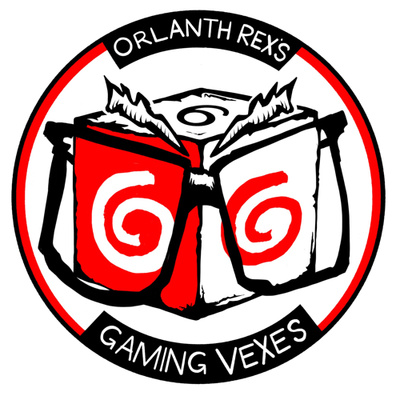
Given the host’s name, I’m surprised it took 29 episodes to get to a Gloranthan episode, but here it is! Steve, aka “Orlanth Rex“, interviews his players (including Doc Cowie, which we interviewed ourselves previously) about their 5-year RuneQuest game.
The episode includes a few interesting discussions about what makes something “Gloranthan”, moving from RuneQuest 2nd edition to RuneQuest Glorantha to OpenQuest, using a hack of Blades in the Dark to run heists in Boldhome, and more! Listen here or in your favourite podcast app.
Exploring Glorantha Enters History
Guest section by Jörg
J-M and Evan discuss the First Age of Glorantha, and the grey period before the Dawn, known as the Silver Age in Dragon Pass and surrounding lands.
About halfway into the episode, J-M claims that theirs is “the Glorantha 101 show. For the Glorantha 200 & 300 level show, go check out the God Learners podcast.” No pressure, and thanks for the shout-out.
Tales of Tarsh Playtest
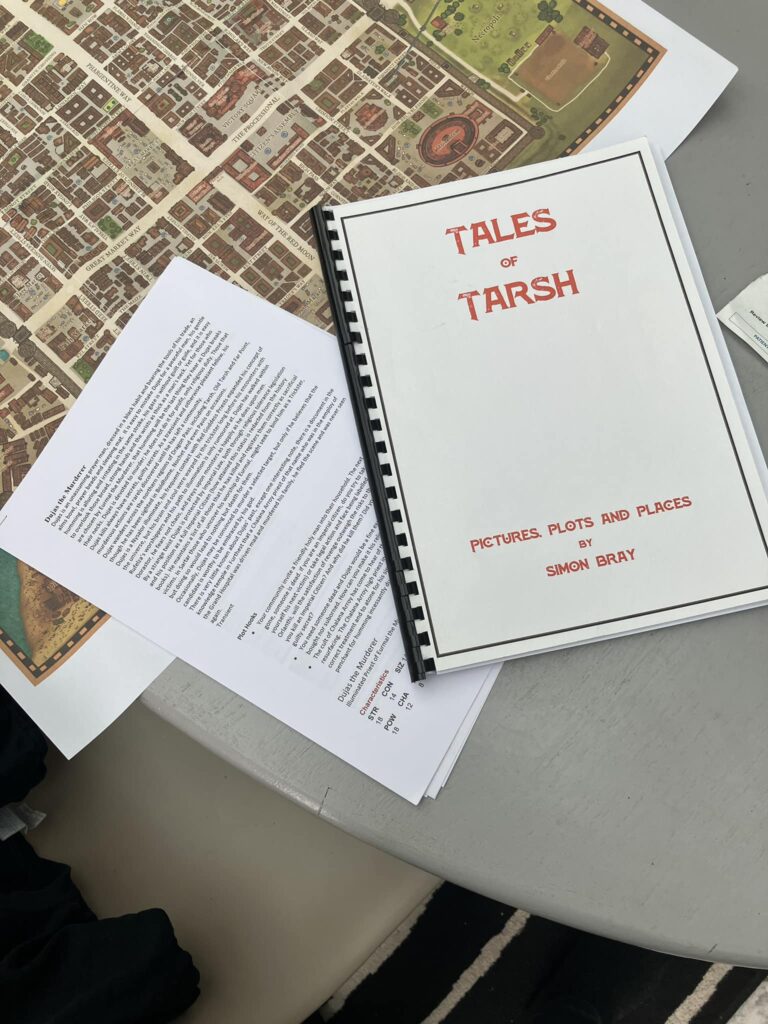
It looks like Simon Bray is playtesting some very interesting stuff… including two of my favourite things: Tarsh, and maps!
Fun with ChatGPT
Over on BRP Central, Styopa asked AI chat bot ChatGPT about Glorantha… the results are not super awesome, but they’re kinda fun to read:
In the beginning, the world was shrouded in darkness, and the gods were trapped in the underworld. The goddess Eiritha, mother of all life, decided that something had to be done to bring light to the world. She gathered together a group of heroes known as the Lightbringers and charged them with the task of bringing back the sun.
If you squint hard enough, it looks vaguely plausible… which is sort of what you get with AI-generated content in general anyway so far. At least all the gods seem to have the correct number of fingers!
Elsewhere on Arachne Solara’s Web
Not everything is about Glorantha, although most things are! Here are loosely relevant things that we found on the interwebs.
Literature in Ancient Egypt
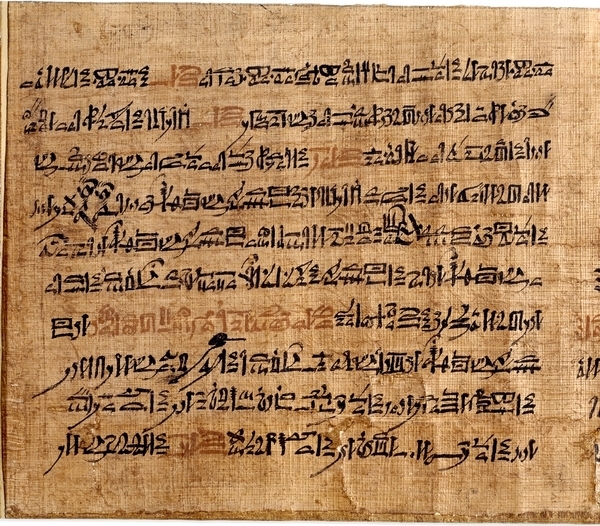
This article from the British Museum blog gives a glimpse of Ancient Egyptian literature, and it’s lovely! (you know, besides the part about British imperialism stealing historical artifacts from African cultures)
The picture above is an excerpt of A Tale of Two Brothers, a story that dates back to at least 13th century BCE. It’s… err… pretty messed up:
It begins by presenting an idyllic household consisting of Anubis, his wife and his brother, Bata. Their pleasant lifestyle is disrupted when the wife of Anubis unsuccessfully tries to seduce her brother-in-law. Upset by the humiliation of his refusal, she claims that Bata attacked her. Believing his wife, Anubis initially turns against his brother and forces him to leave the family. Anubis later discovers his wife’s disloyalty and kills her, and the brothers are reunited. Meanwhile the gods have fashioned a wife for Bata. Unfortunately she rejects him in favour of the king. To win her over Bata assumes a sequence of different forms, the last being a Persea tree. Bata’s wife orders the tree to be cut down. A splinter from the tree flies into her mouth, ‘she swallowed it and in a moment she became pregnant’. Bata is reborn, now as her son, and becomes king of Egypt. He elevates his brother, Anubis, to succeed him, overcoming the catastrophes that had beset the pair.
The papyrus owned by the British Museum even has an attribution to “the scribe Inena”. And speaking of scribes, the article talks about literary works being copied, preserved, and reworked from one century to the next. One of the museum’s exhibits has nine versions of one work, the “Teaching of Khety”, also known as “The Satire of the Trades“, also known as “what passes for shitposting in 13th century BCE Egypt“. The author mocks many professions. The article does have a passage from the story, but I find the other passage from Wikipedia funnier for some reason:
“His apron is mere rags and the rest-house far behind him. His arms are dead from wielding the chisel, and every measurement is wrong; He eats his food with his fingers and washes once a day”
By the way, some of the copies of the Satire were on papyrus rolls, but most have been copied on my new word of the day: ostraca.
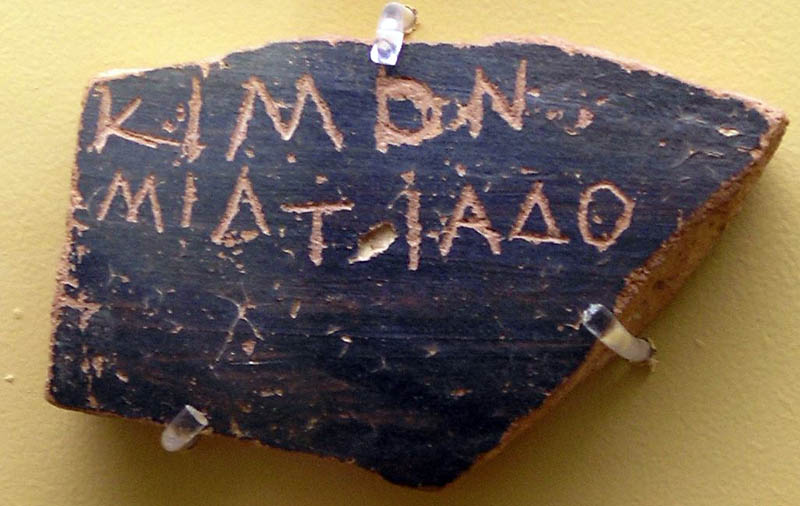
An ostracon is a piece of pottery or stone that was broken from off and used for scratching some quick writing onto. Ancient people didn’t have post-its, but they did have shitloads of pottery. So if you needed to write something, you’d look in the “discarded pottery” basket and grab something there.
There are a couple of other Egyptian tales mentioned in the British Museum article, including some that have been reworked and adapted all the way into modern times.
Thank you for reading
That’s it for this week! Please contact us with any feedback, question, or news item we’ve missed!

